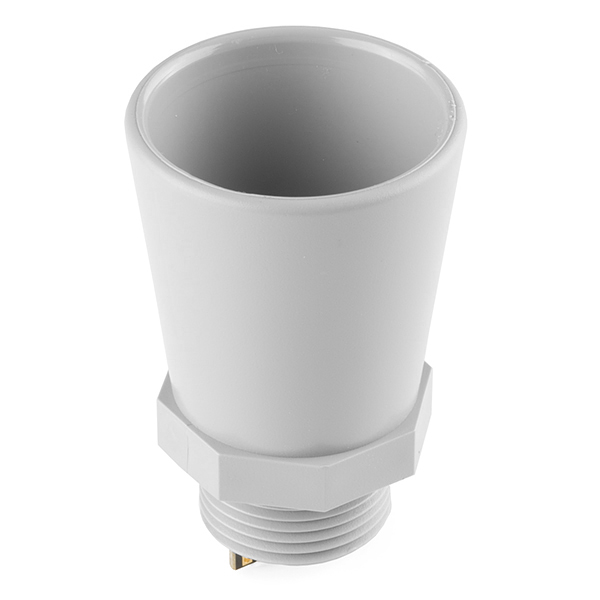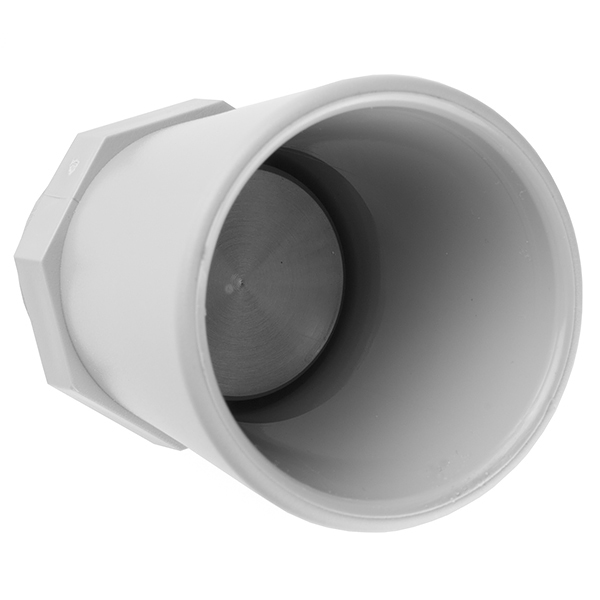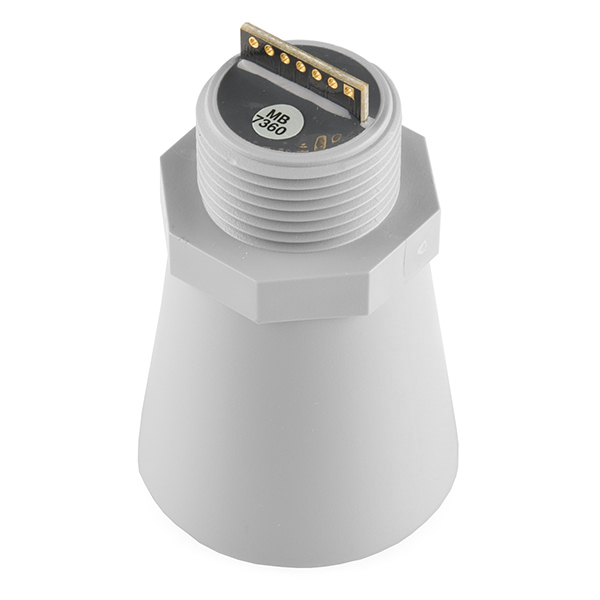×
SparkFun will be closed Nov. 28th and Nov. 29th in observance of Thanksgiving. Any orders qualifying for same day shipping placed after 2:00 p.m. MST on Wednesday, Nov 27th will be processed on Monday, Dec 1st. Wishing you a safe and happy holiday weekend from all of us at SparkFun!
Ultrasonic Range Finder - HRXL-MaxSonar-WR
This outdoor sensor provides very short to long distance detection and ranging in a compact, robust PVC housing. The ultrasonic sensor meets the IP67 water intrusion standard and matches standard electrical 3/4-inch PVC pipe fittings.
High output acoustic power combined with continuously variable gain, real-time background automatic calibration, real-time waveform signature analysis, and noise rejection algorithms results in virtually noise free distance readings. This holds true even in the presence of many of the various acoustic or electrical noise sources. The HRXL-MaxSonar-WR sensors are factory calibrated to match narrow sensor beam patterns and provide reliable long range detection zones.
- Resolution of 1mm
- 7.5Hz read rate
- Internal temperature compensation
- 42kHz ultrasonic sensor measures distance to objects
- Read from all 3 sensor outputs: Analog Voltage, Serial, Pulse Width
- Virtually no sensor dead zone, objects closer than 30cm range as 30cm
- Operates from 2.7-5.5V
- Low 2.9mA average current requirement
- Small, light weight module
- Designed for easy integration into your project or product
- Operational temperature -40°C to +65°C (-40°F to +149°F)
- Realtime automatic calibration (voltage, humidity, and ambient noise)
- Firmware filtering for excellent noise tolerance and clutter rejection
- Weather resistant (IP67), optional chemical resistant F-Option
- Matches standard electrical 3/4-inch PVC pipe fittings for easy mounting (3/4-inch National Pipe Thread Straight)
- Long narrow detection zone
- RS232 Serial Output
- Datasheet (MB7360)
- Beam Width Explanation
- Maxbotix FAQ
-
Checkout Mikey Sklar's flame-based trampoline, the high-lighter, using the EZ1!
Ultrasonic Range Finder - HRXL-MaxSonar-WR Product Help and Resources
"RS232" Output or Inverted TTL
If the ultrasonic range finder indicates that it has an "RS232 Serial Output" and is outputting an inverting signal with the voltage level based on Vcc, you could just use an inverting circuit using a transistor to invert the signal. This is not a standard RS232 that uses +/-12V. There are a few methods of flipping this signal through hardware or software. The resources and going further will provide specific examples.
Inverting Signal w/ Hardware
Doing a quick test using a retired NPN transistor from our storefront, I was able to get it working based on the circuit using a RedBoard Programmed with Arduino. I was using an Arduino so Vcc in my circuit was 5V. Since it's basically two diodes within the transistor, you will want to use resistors to limit the current. I just used two 330Ohm resistors just like I was turning on an LED. You probably do not need to do this but the values might need to be adjusted when using it at higher speeds or if the transistor is not fully turning ON/OFF. Testing with a multimeter, it worked as expected. An input of 5V would result in 0V (logic LOW) on the output since the transistor was turning on. With an input of 0V, the transistor would not be conducting so the output would be held HIGH at 5V. Using an Arduino serial passthrough for further testing, I was able to view the ultrasonic sensor's output data without any problems.
"RS232" Output and Inverting w/ Software
Otherwise, you could be clever in writing your code to store the value and possibly apply some sort of logical NOT operation. In Arduino, there is a special feature using software serial that inverts the signal by setting a parameter to true [ "Software Serial Constructor" – https://www.arduino.cc/en/Reference/SoftwareSerialConstructor ]. There was someone in the Arduino forums that provided example code to invert the output, parse the data, and output it through the serial monitor here => [ User "Goldthing" - http://forum.arduino.cc/index.php?topic=114808.msg864009#msg864009 ].
Connecting Ultrasonic Sensor to Raspberry Pi
There is a tutorial from MaxBotix that shows you how to connect ultrasonic sensors to Raspberry Pis => [ http://www.maxbotix.com/Raspberry-Pi-with-Ultrasonic-Sensors-144/ ]. Certain ultrasonic sensors listed in the article require an inverter. If the ultrasonic range finder's output serial output is " RS232 " like the sensors listed under "Ultrasonic Sensors that Require an Inverter" , this indicates that the signal is basically an inverted output with the voltage level based on Vcc.
Therefore, you would need to follow the tutorial and use a serial inverter in order to use it with the Raspberry Pi. If you are using a Raspberry Pi a transistor, Vcc should be 3.3V since the Pi uses a 3.3V system.
Resources and Going Further
Connecting HRXL-MaxSonar-WR to Raspberry Pi
There is a tutorial from MaxBotix that shows you how to connect ultrasonic sensors to Raspberry Pis => [ http://www.maxbotix.com/Raspberry-Pi-with-Ultrasonic-Sensors-144/ ]. The Ultrasonic Range Finder - HRXL-MaxSonar-WR's manufacturer part number is MB7360. Looking at the application notes and checking the datasheet on page 3 for the MB7360 [ https://cdn.sparkfun.com/datasheets/Kits/HRXL-MaxSonar-WR_Datasheet.pdf ], it looks like the serial output is RS232 like the sensors listed under "Ultrasonic Sensors that Require an Inverter" .
Therefore, you would need to follow the tutorial and use a serial inverter in order to use it with the Raspberry Pi.
Core Skill: Soldering
This skill defines how difficult the soldering is on a particular product. It might be a couple simple solder joints, or require special reflow tools.
Skill Level: Noob - Some basic soldering is required, but it is limited to a just a few pins, basic through-hole soldering, and couple (if any) polarized components. A basic soldering iron is all you should need.
See all skill levels
Core Skill: Programming
If a board needs code or communicates somehow, you're going to need to know how to program or interface with it. The programming skill is all about communication and code.
Skill Level: Rookie - You will need a better fundamental understand of what code is, and how it works. You will be using beginner-level software and development tools like Arduino. You will be dealing directly with code, but numerous examples and libraries are available. Sensors or shields will communicate with serial or TTL.
See all skill levels
Core Skill: Electrical Prototyping
If it requires power, you need to know how much, what all the pins do, and how to hook it up. You may need to reference datasheets, schematics, and know the ins and outs of electronics.
Skill Level: Competent - You will be required to reference a datasheet or schematic to know how to use a component. Your knowledge of a datasheet will only require basic features like power requirements, pinouts, or communications type. Also, you may need a power supply that?s greater than 12V or more than 1A worth of current.
See all skill levels
Comments
Looking for answers to technical questions?
We welcome your comments and suggestions below. However, if you are looking for solutions to technical questions please see our Technical Assistance page.
Customer Reviews
5 out of 5
Based on 1 ratings:
1 of 1 found this helpful:
Not the best thing I've ever owned, but certainly the best thing for measuring my irrigation pond level.
I use these sensors for measuring my irrigation pond level. I'm using the analog output connected to an ADC port on a STM32-H152 Olimex board. The Olimex board has a Digi XBee PRO 950 connected via a UART port that then transmits readings to a Beaglebone 200+ feet away inside a building which also has a Digi XBee PRO 950. The Beaglebone (using LibWebsockets and Javascript) serves up web pages with the data received. The MaxSonar has been outside exposed to the elements (central Oregon) for 1 year plus now and has not failed once. 5 Star product, works perfect and is very accurate.





For those who don't want to search the datasheet, the max range is 5 meters, and it returns the distance to the closest target it sees.
Hello, this is Tom Bonar from MaxBotix Inc. We have recently designed and released a sensor that has snow depth measurement as one of the recommended application uses. Like shardbearer stated, typically ultrasonic sensors are not recommended with soft fluffy targets.
The new MB7363 (http://maxbotix.com/Ultrasonic_Sensors/MB7363.htm) sensor has a high acoustic gain, this makes the sensor recommended for applications that have minimal ultrasonic sound reflected back to the sensor. With snow falling in Minnesota, our engineers are running this sensor outside our facility and have found the sensor to have very good results even with light snow fall.
Our engineers recommend that the HR-MaxTemp be used in conjunction with the MB7363 for the best accuracy. When mounting the HR-MaxTemp you will want to make sure that the mounting is between the sensor and the ground.
Please let me know if you have any questions.
Best regards,
Tom Bonar Technical Support of MaxBotix Inc. Phone: (218) 454-0766 Fax: (218) 454-0768 Email: thomas@maxbotix.com Web: www.maxbotix.com Follow us on Facebook at: http://www.facebook.com/pages/MaxBotix-Inc/125159384204938
Technical support and sales are subject to the terms and conditions listed on our website at http://www.maxbotix.com/ MaxBotix, MaxSonar,EZ0, EZ1, EZ2, EZ3, EZ4, AE0, AE1, AE2, AE3, AE4, WR1, WRA1, and WRLA1 are trademarks of MaxBotix Inc.
Are these suitable for snow depth monitoring?
The 7389 is the appropriate choice for snow depth monitoring. Its filter is set to ignore smaller targets and will only report the range to the largest. I've got a few stations using the 7389, just need to make sure you shield the external temperature sensor from the sun.
Usually ultrasonic sensors don't work too well with soft fluffy stuff. Maybe try the Sharp Infrared sensor? https://www.sparkfun.com/products/8958
"Virtually no sensor dead zone, objects closer than 30cm range as 30cm" ... ?? Edit: Oops, sorry i might have read it too fast. It means any object closer then 30cm will be read as 30cm , right? That probably makes not very good for robots.. :/